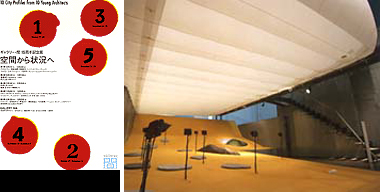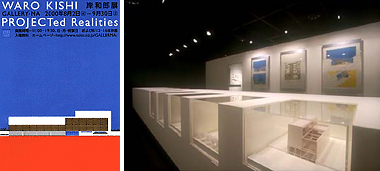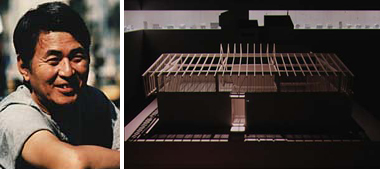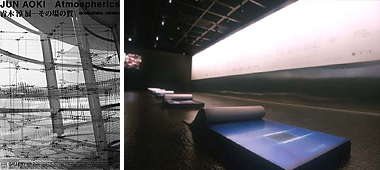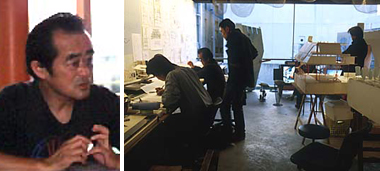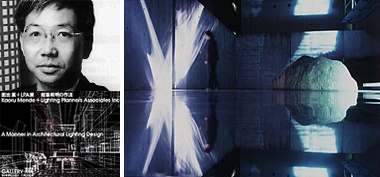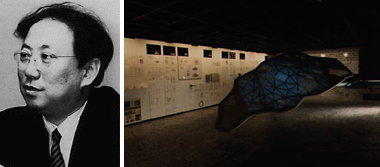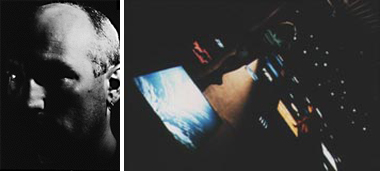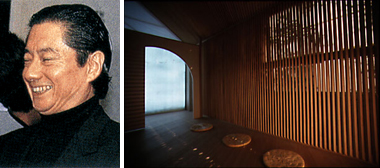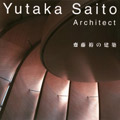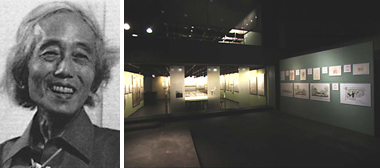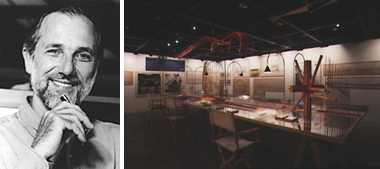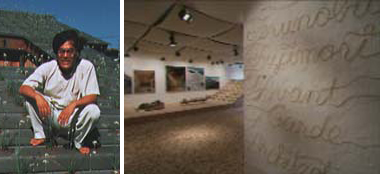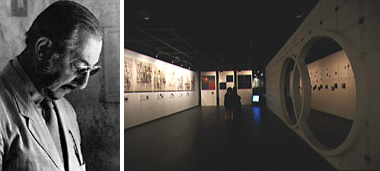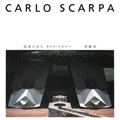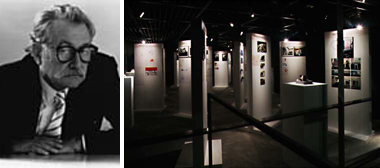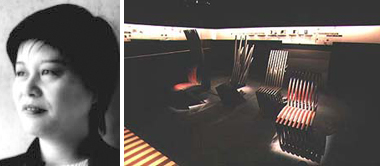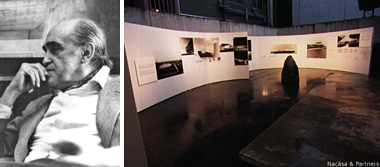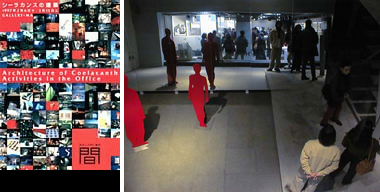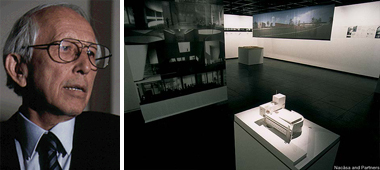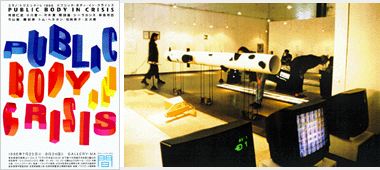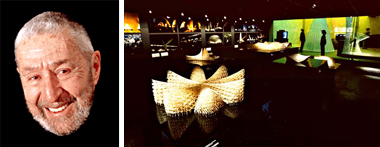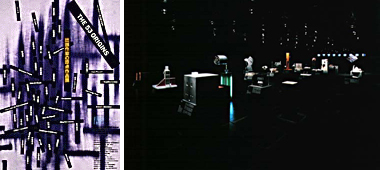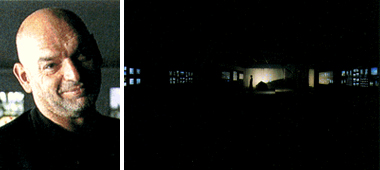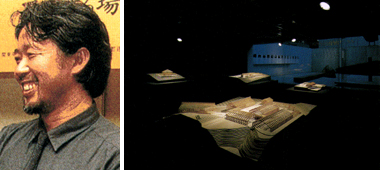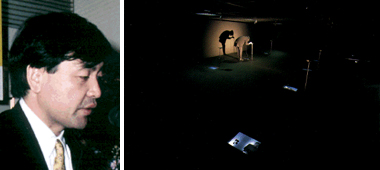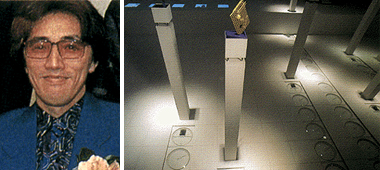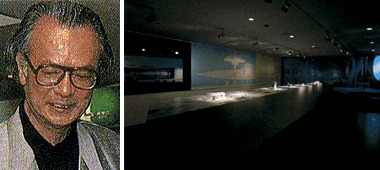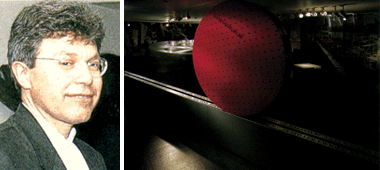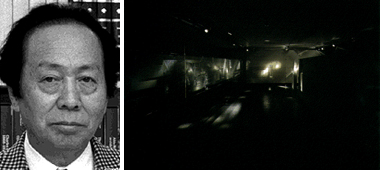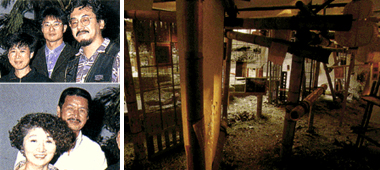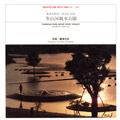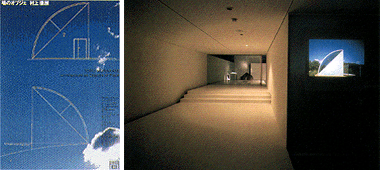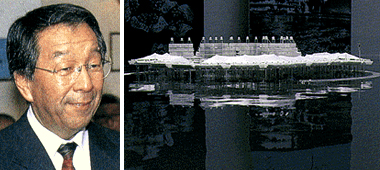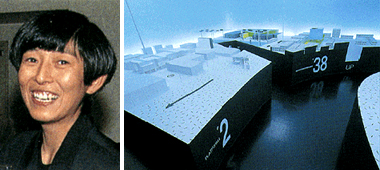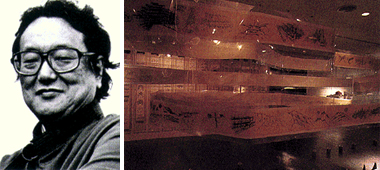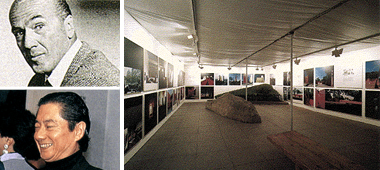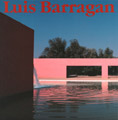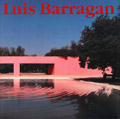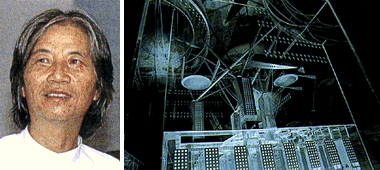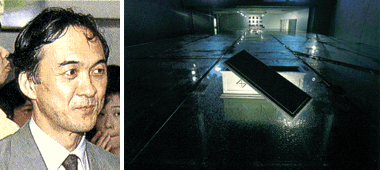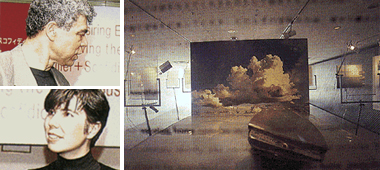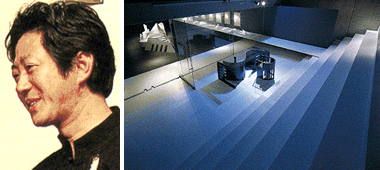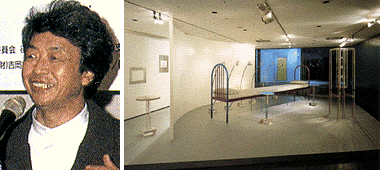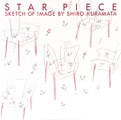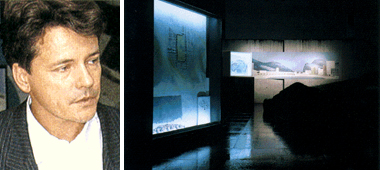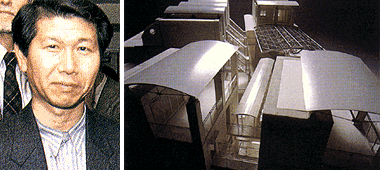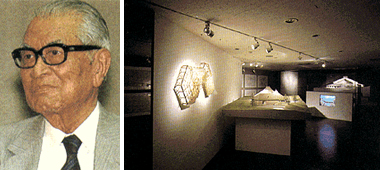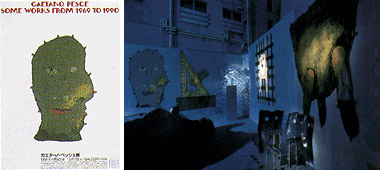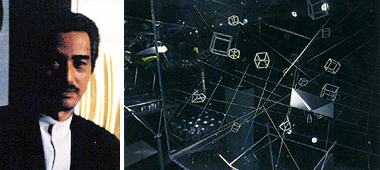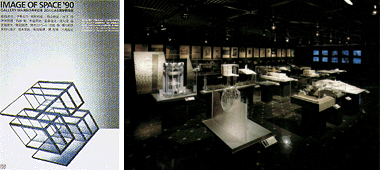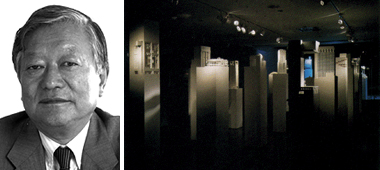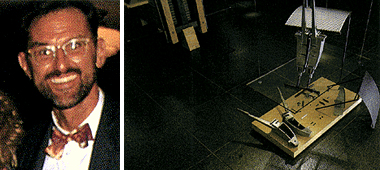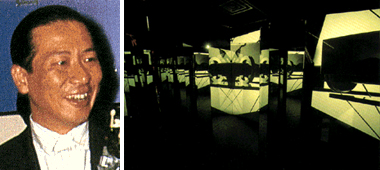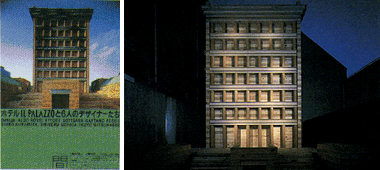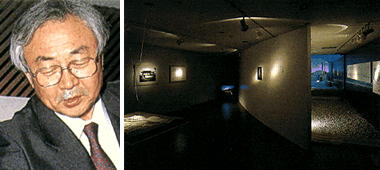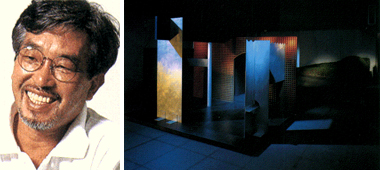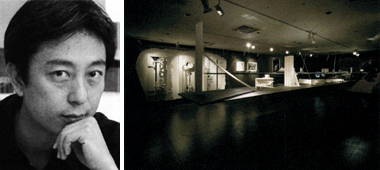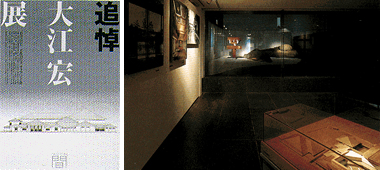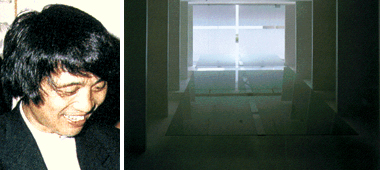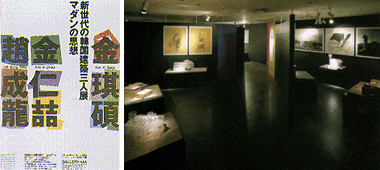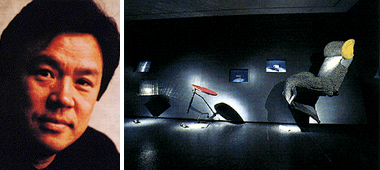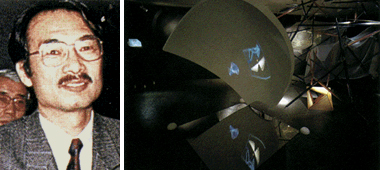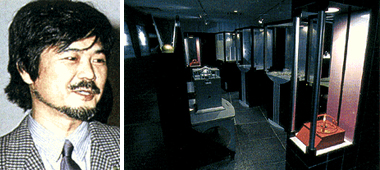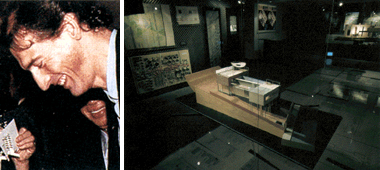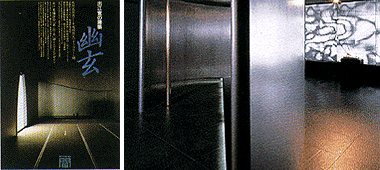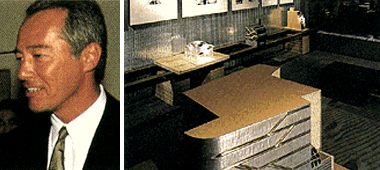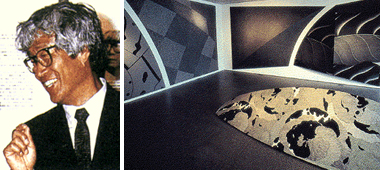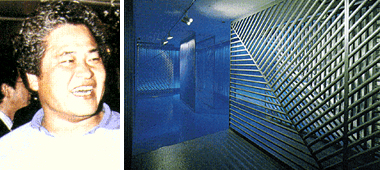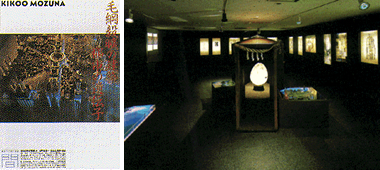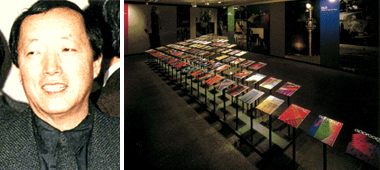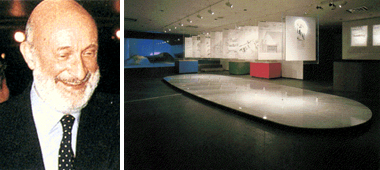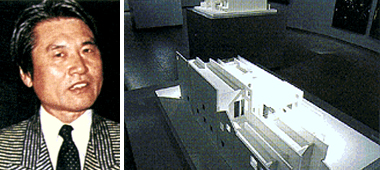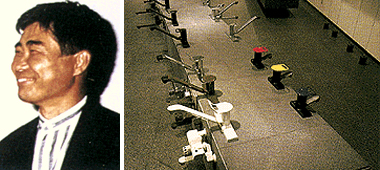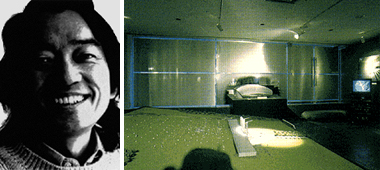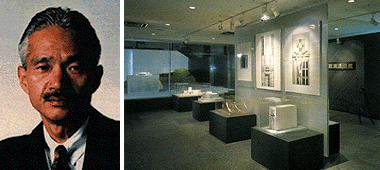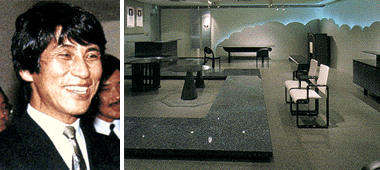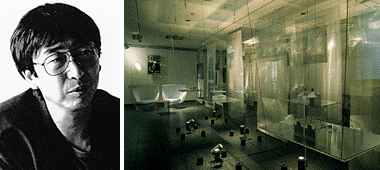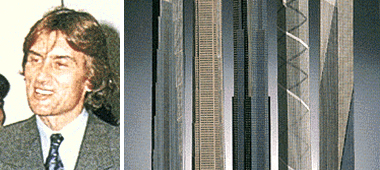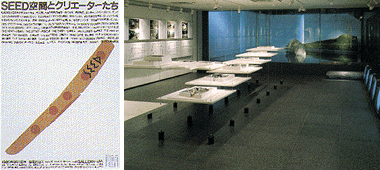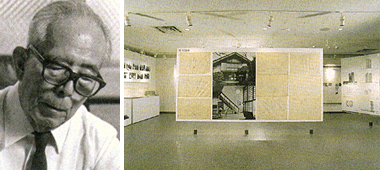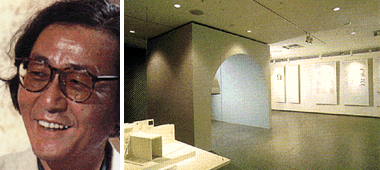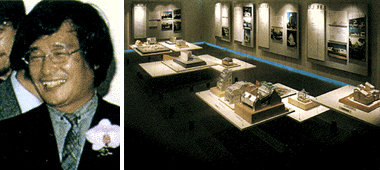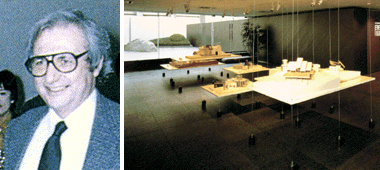- ExhibitionsTOTO GALLERY·MA
- Current Exhibition
- Upcoming Exhibitions
- Past Exhibitions
- ExhibitionsExternal Locations
- Upcoming Exhibitions
- Past Exhibitions
- Lectures
- Upcoming Lectures
- Past Lectures
- Visitor Information
- Directions
- Gallery Infomation
- Museum Shop
- Bookshop TOTO
Cultural Activities
TOTO GALLERY·MA
TOTO Publishing
Bookshop TOTO
Past Exhibitions
October 17―December 23, 2000
Direction: Hitoshi Abe, Taro Igarashi, Masashi Sogabe, Manabu Chiba
1st: Void | Oct. 17–28, 2000
Atelier Bow-Wow/Yoshiharu Tsukamoto+Momoyo Kaijima: Pet Architecture Project
Facter N Associates/Manabu Chiba+Nancy Finley: Renewal of “Urban Void”
2nd: Atmosphere | Oct. 31–Nov. 11, 2000
Shuhei Endo: Rooftecture/BUNYUUTAI
Ryue Nishizawa: Atmosphere
3rd: Agglomeration | Nov.14–25, 2000
Hitoshi Abe+Yasuaki Onoda: 10,000
Katsu Umebayashi: Reconsidering the pooblemations of housing
4th: Hybrid | Nov. 28–Dec. 9, 2000
Klein Dytham architecture/Astrid Klein+Mark Dytham: DELUXE TOWER
Matsuoka Wang Architects/Kyoko Matsuoka+Steven Tachun Wang: LINE→STAIN
5th: Geography | Dec. 12–23, 2000
MIKAN/Kiwako Kamo+Yosuke Kumakura+Masashi Sogabe+Masayoshi Takeuchi+Manuel Tardits: City Golf
Katsuhiro Miyamoto: dis-location
1st: Void | Oct. 17–28, 2000
Atelier Bow-Wow/Yoshiharu Tsukamoto+Momoyo Kaijima: Pet Architecture Project
Facter N Associates/Manabu Chiba+Nancy Finley: Renewal of “Urban Void”
2nd: Atmosphere | Oct. 31–Nov. 11, 2000
Shuhei Endo: Rooftecture/BUNYUUTAI
Ryue Nishizawa: Atmosphere
3rd: Agglomeration | Nov.14–25, 2000
Hitoshi Abe+Yasuaki Onoda: 10,000
Katsu Umebayashi: Reconsidering the pooblemations of housing
4th: Hybrid | Nov. 28–Dec. 9, 2000
Klein Dytham architecture/Astrid Klein+Mark Dytham: DELUXE TOWER
Matsuoka Wang Architects/Kyoko Matsuoka+Steven Tachun Wang: LINE→STAIN
5th: Geography | Dec. 12–23, 2000
MIKAN/Kiwako Kamo+Yosuke Kumakura+Masashi Sogabe+Masayoshi Takeuchi+Manuel Tardits: City Golf
Katsuhiro Miyamoto: dis-location
Architects born in the 1960s came to the forefront of the architectural scene in the period following the bursting of Japan’s bubble economy in the 1990s. Since then, they have been demonstrating original methods of design and styles of activites. This exhibition presents a surging architectural wave raised concurrently by 10 units of young architects.—Taro Igarashi
August 2―September 30, 2000
Exhibitor: Waro Kishi
Architecture does indeed have a certain dimension that is expressible in a gallery, that is, an aspect that can be expressed on an abstract level. That is why we have the exhibition format in the first plece. However, architecture has another aspect grounded in reality. In coming into being, architecture responds to diverse conditions; e.g. site, society, economy and culture.—Waro Kishi
May 20―July 15, 2000
Direction: Makoto Ueda, Hiroshi Naito, Yoshifumi Nakamura, Kenichi Yamazaki
This exhibition focuses on Miyawaki’s housing projects, which were always the center of his prolific activity, and exhibits eight representative works including “Matsukawa Box”, “Funabashi Box”, and “Blue Box”.
March 3―April 28, 2000
Exhibitor: Jun Aoki
I’m interested in composition. But I don’t wish to design actual buildings for the sake of “expressing” the composition. I’m interested in structure. But I don’t wish to express structure.—Jun Aoki
December 4, 1999―February 19, 2000
Phase 1: Dec. 4–22, 1999 | Recreation
Phase 2: Jan. 11–29, 2000 | Movement
Phase 3: Feb. 1–19, 2000 | Chaos
Exhibitor: Osamu Ishiyama
Phase 2: Jan. 11–29, 2000 | Movement
Phase 3: Feb. 1–19, 2000 | Chaos
Exhibitor: Osamu Ishiyama
“Open Technology”, the underlying theme of the exhibiton, is, simply put, the idea that a new world is out there. We can catch a glimpse of that world if we examine the implications of gardening, a currently fashionable pastime. If we can think about and create our own garden, then why can’t we think about and create our own environments?—Osamu Ishiyama
September 25―November 20, 1999
Exhibitor: Kaoru Mende
“Manners” are necessary to lay the trap of comfortable air using light. We learn manners in architectural lighting design from nature, from historical architecture and from the techniques of great architects. Through this exhibition I decided to fully disclose the limitlessly liberal creative energy of lighting design and the somewhat more limited but profound craftsmanship of light.—Kaoru Mende
July 2―September 4, 1999
Exhibitor: Chiaki Arai
“Architecture for arousing”, that is, architecture that rouses or inspirits, must be part of a larger cultural activity prior to and after cnstruction. It is necessary to lift people’s spirits, that is, to make people feel that the building is their own.
March 5―April 24, 1999
Exhibitor: Shigeru Ban
The Japanese Pavilion for the World Exposition Expo 2000 Hannover, Germany, is my current project. Here, we introduce various attempts made during the design and construction processes, including some new developments mainly for the Japanese Pavilion, Expo 2000 Hannover and some other ongoing projects.—Shigeru Ban
December 5, 1998―February 20, 1999
Exhibitor: Yann Kersalé
Yann Kersalé, a French artist, forcuses on light in his art and design projects. In this exhibition, the space is divided into three zones. Each of them represents, “past”, “present”, and “future”, and creates pageants of light along these themes.
September 19―November 14, 1998
Exhibitor: Yutaka Saito
There are wonderful sections that speak eloquently of space. My desire has long been to create works of architecture in which such sections appear. In this exhibition, I am presenting in plan and three-dimensional form a number of sections I have conceived.—Yutaka Saito
July 10―August 1, 1998
Fumitaka Nishizawa, the second head of Sakakura Associates, was a well-known architect who left behind many works. In addition to his activities as an architect, Nishizawa was also deeply interested in the relationship between traditional Japanese architecture and gardens.—Keisuke Fujii
April 25―June 27, 1998
Exhibitor: Renzo Piano
This exhibition is the Japanese stage of the world exhibition tour “Renzo Piano+Building Workshop—Out of the Blue”, a retrospective of the works of Renzo Piano. It reveals in full 4 works selected from the main collection.
February 13―April 4, 1998
Exhibitor: Terunobu Fujimori
Here I present all five of my works. Using materials collected from nature. I undertook these projects while reflecting on the question of the relationship between nature and artifact.—Terunobu Fujimori
November 11―December 20, 1997
Guest Curator: Franca Semi
Direction: Yutaka Saito
Direction: Yutaka Saito
This exhibiton introduces the Brion Cemetery. The photographic panels show the work in different seasons of the year. The exhibition also attempts to reveal the hidden essence of Scarpa’s architectural viewpoint, spatial method and perfectionistic approach to details.—Yutaka Saito
September 24―November 1, 1997
Exhibitor: Ettore Sottsass
The exhibition by the architect Ettore Sottsass at the GALLERY·MA in Tokyo, was divided into 2 sections: exhibited in the first section, at the ground floor of the Gallery, were 9 pieces of furniture designed by Sottsass in 1996 for the Gallery Mourmans of Knokke-Zoute, Belgium.
June 7―July 19, 1997
Exhibitor: Kazuko Fujie
I hope that not only representing form but everything including selection of materials and handmade details induces various movements of people through the all process of creation, which results in representing fresh scenery. —Kazuko Fujie
April 4―May 24, 1997
Exhibitor: Oscar Niemeyer
I am not attracted by straight angles. Nor by straight, head and inflexible lines created by man.
I am attracted by free-flowing, sensuous cueves.
—Oscar Niemeyer
I am attracted by free-flowing, sensuous cueves.
—Oscar Niemeyer
February 6―March 15, 1997
Exhibitor: Coelacanth (Yasuyuki Ito, Susumu Uno, Kazumi Kudo, Masao Koizumi, Kazuhiro Kojima, Mitsumasa Sampei, Maho Hiiro, Hiroshi Horiba)
“Coelacanth architects” centers around eight partners who design and conduct research activities individually, in teams, or together as a group. In order to convey a natural sense of how a diverse range of activities is carried out by multiple subjects, we have transferred the Coelacanth architects “Office” andplaced it on display.
November 20, 1996―January 18, 1997
Exhibitor: Fumihiko Maki
The present exhibition focuses on Fumihiko Maki’s truly current work. Along with numerous studio models, structure component models, drawings, and site photos, the exhibition delivers a report on the tension surrounding actual sites that have just been completed or are presently in progress.
September 11―October 26, 1996
Exhibitor: Neil M. Denari
For Denari, contemporary architecture exists within a society filled with a mixture of coded images that trancends the concrete “thing” itself. Denari seeks to discover the possibilities of architecture within such a society, as well as how architecture can be made to fuse with society. Denari offered one solution to these questions in the space of GALLERY·MA.
July 23―August 24, 1996
Exhibitors: Hitoshi Abe, Shinichi Ogawa, Atsushi Katagi, Kengo Kuma, Coelacanth Architects, Kazuyo Sejima, Kiyoshi Sey Takeyama, Norihiko Dan, Tom Heneghan, Matsuoka Wang Architects
GALLERY·MA is sponsoring an exhibition titled “Milan Triennale1996: Public Body in Crisis” to commemorate the participation of the Japan team in this year’s architectural and design festival “19th Milan Triennale” held in Milan.
May 17―June 22, 1996
Exhibitors: Eisaku Ushida, Kathryn Findlay
Usually when we walk around the city we hold a map of it in our minds framed by the memory of our own space. Each person has their individual image of the city based on that person’s psychological or physical experiences, consequently we walk around that city as if referring to some sort of personal navigational chart.
March 15―April 27, 1996
Direction: Yutaka Saito
Candela has taken the simple geometric shape of the HP shell and used it to introduce a dazzling array of variations into architecture. All of his works, including this enormous 60m×90m space, are constructed in four centimeter thick reinforced concrete.
December 5, 1995―January 31, 1996
Exhibitors: Takefumi Aida, Tadao Ando, Arquitectonica, Atelier Zo, Santiago Calatrava, Charles Correa, Norihiko Dan, Diller+Scofidio, Vittorio Gregotti, Hiroshi Hara, Itsuko Hasegawa, Kunihiko Hayakawa, Kazuhiro Ishii, Osamu Ishiyama, Toyo Ito, Kan Izue, Helmut Jahn, Joh Sung Yong, Motomi Kawakami, Kazuo Kawasaki, Kiyonori Kikutake, Kim Ki Seok, Kim In Cheurl, Atsushi Kitagawara, Toshiyuki Kita, Yasuo Kondo, Kengo Kuma, Kisyo Kurokawa, Masayuki Kurokawa, Daniel Libeskind, Koichi Makishi, Tadanaga Miyamoto, Morphosis, Kiko Mozuna, Toru Murakami, Hiroshi Naito, Jean Nouvel, Gaetano Pesce, Christian de Portzamparc, Kijyo Rokkaku, Seizo Sakata, Kazuyo Sejima, Kazuo Shinohara, Eizo Sueyoshi, Asao Sugama, Takashi Sugimoto, Edward Suzuki, Ryoji Suzuki, Shin Takamatsu, Sei Takeyama, Shigeru Uchida, Riken Yamamoto, Shoei Yoh
For our 10th Anniversary Exhibition we have chosen the theme of “Creative Origins.” In this exhibition we have asked each of the architects and designers whose work we have exhibited in the past to choose those works which they consider their “original works” and which best express their current position to be exhibited on a single stage.
September 19―November 2, 1995
Exhibitor: Jean Nouvel
Nouvel, who made his dramatic debut in the French architecture world with his “Institut du Monde Arabe” (1987), is one of the most closely watched figures in architecture today. His emotional architecture skillfully manipulates natural lighting by permeating, reflecting, and refracting it—elevating it to create amystical space.
June 9―July 22, 1995
Exhibitor: Hiroshi Naito
The exhibit is divided into two parts, a black space consisting of past works represented by wood models, and a white space consisting by white models to symbolize his future works. Each model in the series of models conveys a notion of the forms Naito seeks to create, as well as the content of his message.
April 12―May 27, 1995
Exhibitor: Charles Correa
Correa is one of India’s leading contemporary architects. His architecture strongly reflects a uniqueness and cultural style deeply rooted in India's natural climate, and is acturally quite distinct from the international style of architecture.
February 10―March 31, 1995
Exhibitor: Kengo Kuma
This exhibit possensses an unusual atmosphere not seen before in previous shows. All of Kuma’s works have been transferred to CD-ROM, do that visitors are free to view and manipulate them on the monitor screens themselves.
November 8―December 10, 1994
The final Isoya Yoshida Award was given in 1993. In all, a total of some sixty-one persons, including special award winners, received the prize. This exhibit takes a look at the history of the award.
September 10―October 22, 1994
Exhibitor: Santiago Calatrava
Sixteen individual objects stand in the newly expanded, two-floor exhibition space. One look confirms they are not architectural models, but rather fully independent sculptures.
June 25―July 25, 1994
Exhibitor: Kazuo Kawasaki
Kawasaki presents models of music boxes he has created to pay tribute to twelve philosophers and artists of his choice, placed upon twelve columns. Clock have been imbedded in the floor to display the time elapsed between the birth and death of each of twelve figures.
May 10―June 11, 1994
Exhibitor: Kazuo Shinohara
The displays in this exhibition share the same quality as the works themselves, insofar as they express Shinohara’s conviction that the fewer the conditions placed upon the structures, the more inflential power they possess. The exhibition presents models of nine of Shinohara’s projects, arranged systematically in a straight line.
March 9―April 16, 1994
Exhibitor: Daniel Libeskind
In this exhibition, a twenty-meter track extends from the entry, pass the glass wall and into the rear of the garden, upon which a disc two meters in diameter shuttles slowly to one end of the track and back and again. The device is entitled “Line and Wheel”.
January 18―February 22, 1994
Exhibitor: Yoshiro Ikehara
All one can see in this dimly its space are rising beams of light. The entire exhibit focuses on “The Asakura Isokichi Museum” (1993). Plans, cross sections or life-size illustrations have been silkscreened onto transparent acrylic panels.
October 21―December 11, 1993
Exhibitor: Atelier Zo (Reiko Tomita, Yasuhiro Higuchi, Ichiro Machiyama)
Stepping into this exhibition, one is struck by the sensation of having suddenly walked onto some back street abandoned lot. Earth, fallen leaves and bamboo foliage are strewn about, and in the corner, some bales of hay and roof tiles lie stacked in a heap.
September 3―October 9, 1993
Exhibitor: Toru Murakami
The exhibition space is done all in white. The only items actually on exhibit are this white floor, and the floaring white models of twelve residences encased in transparent plastic.
June 11―July 17, 1993
Exhibitor: Arquitectonica (Bernardo Fort-Brescia, Laurinda Spear)
The architecture of Arquitectonica enables us to see colors reduced to their basic forms, such as red, green, yellow and white. This type of coding corresponds to classifications of the elements in architectural construction.
April 24―May 31, 1993
Exhibitor: Kiyonori Kikutake
As soon as they enter the gallery, visitors are struck by the sensation of wide open space. The long road traveled by this architect are on display on seven panels hanging on a long wall extending from the interior of the gallery outdoors, along with models of three of his works, namely “Tokyo Metropolitan Edo-Tokyo Museum” (1993) and “Sky House” (1958).
March 10―April 13, 1993
Exhibitor: Kazuyo Sejima
The walls and ceiling have painted in blue, and the space is filled with almost blinding illumination. Some twelve projects are on display. All the works features, including plans, are presented using equally abstract models, appearing like a world that has been processed with high-level graphics.
January 23―February 27, 1993
This exhibition features the sketchbook of Kim Swoo Geun, filled with copious drawings, suspended from between the two walls of the gallery, and hanging down from the ceiling as well.
October 16―November 14, 1992
Photography: Yutaka Saito
The exhibition is made up of photographs taken by Yutaka Saito, who succeeds in capturing the essence of Barragán’s style with his architect’s eye.
September 4―October 6, 1992
Exhibitor: Hiroshi Hara
Once cannot describe the work of Hiroshi Hara without including the term “City”. In the exhibition, Hara puts to the test the “Multilayered Theory of the City”. Using a three-dimensional lattice, he tries to represent the “burst” of the city, that is, its capacity for self-transformation, self-destruction and “repair” that is realized through the accumulation of memories of its transformation.
July 1―July 31, 1992
Exhibitor: Ryoji Suzuki
This exhibition displays Suzuki’s art, furniture, architectural models, photographs, and abstract paintings. The relationship between so many different works may seem elusive, but they are all in fact attempts to analyze Fra Angelico’s religious painting, “Last Judgement”.
May 20―June 17, 1992
Exhibitors: Diller+Scofidio (Elizabeth Diller, Ricardo Scofidio)
These two highly innovative artists use a combination of installation and performance art to present their own personal statements. In this exhibition, several realities of their own design, using mental images in order to reconstruct an image of the whole.
March 19―April 25, 1992
Exhibitor: Norihiko Dan
A number of Dan’s works appear extremely rational and restrained. The simple, almost stoic style of his work is also present in this exhibition.
February 5―March 7, 1992
Exhibitors: Eizo Sueyoshi, Asao Sugama, Yoshikazu Makishi
In this special joint exhibition, the display space has been devided up into three sections, each devoted to the models, photos and drawings of the work of these three Okinawa-based architects.
November 8―December 11, 1991
Exhibitor: Shiro Kuramata
The death of Shiro Kuramata, a leader in Japanese interior design, was sudden and unexpected. Planned by Kuramata while he was still alive, this exhibition and its installations were completed by his staff, who worked to ensure that it remained faithful to his concepts.
September 18―October 25, 1991
Exhibitor: Christian de Portzamparc
The exhibition features eleven urban design projects based on Portzamparc’s concept of urban formation, “Block”. Portzamparc is destinguished by his technique of applying both psychology and sociology to architecture in the seach to create new orders and possibilities.
July 4―August 10, 1991
Exhibitor: Riken Yamamoto
Riken Yamamoto summed up the relationship between architecture and city in his urban planning project entitled “Ryokuentoshi Inter-Junction city” (1991–). For Yamamoto, a single work of architecture carries within it the essence of the city.
May 18―June 21, 1991
Exhibitor: Junzo Yoshimura
While keeping himself well-grounded in Japanese tradition, Junzo Yoshimura has gone about constructing a distinctive world of his own, known as “Yoshimura style”. This exhibition features two of his recent music concert halls.
April 5―May 7, 1991
Exhibitor: Gaetano Pesce
Pesce’s interests extend to include a broad range of activities, from urban planning to interior and furniture design. Upon extering the exhibition, visitors are led unknowingly into his distinctive world.
February 15―March 26, 1991
Exhibitor: Kisho Kurokawa
This exhibition features recent works by Kisho Kurokawa, focusing on eight different museum projects he has undertaken in Japan and overseas. All four walls of the gallery have been divides up into grids, upon which panels have been systematically arrenged to display a combination of photographs and axonometric perspectives.
November 22―December 22, 1990
Exhibitor: Atsushi Kitagawara
The Exhibition features three walls, their surfaces riddled with nearly fifty peep holes. Through them, one can glimpse fragments of Kitagawara’s concepts. In the center of the exhibition space, more fragments of his architecture can be seen floating sealed within seven transparent plastic cubes.
November 6―November 20, 1990
Exhibitors: Takefumi Aida, Amorphe, Kazuhiro Ishii, Osamu Ishiyama, Kan Izue, Toyo Ito, Shigeru Uchida, Yasufumi Kijima, Toshiyuki Kita, Atsushi Kitagawara, Yasuo Kondo, Seizo Sakata, Edward Suzuki, Shin Takamatsu, Kunihiko Hayakawa, Itsuko Hasegawa, Tadanaga Miyamoto, Kiko Mozuna, Shoei Yoh, Kijo Rokkaku
Venue: TOTO Super Space
Venue: TOTO Super Space
In the five years since its opening, GALLERY·MA has held some forty-two exhibitions, a striking average of seven to eight events per year. This retrospective exhibition features models of the work of some twenty past contributors.
October 18―November 13, 1990
Exhibitor: Seizo Sakata+Sakakura Associates Architects and Engineers
24 architectural models have been fixed atop 24 wood columns, systematically placed equidistant to one another. Every 24 curved model has been designed to give the appearance of each project.
September 11―October 8, 1990
Exhibitor: Makiko Minagawa
Textile designer Minagawa is principally known for her work in designing fabric materials. In this exhibition, the display space is set up unlike any others in the past.
June 22―July 26, 1990
Exhibitor: Morphosis (Thom Mayne, Michael Rotondi)
As suggested by its title, this exhibition features a straight presentation of the group’s activities. The metal and wood object places at the center of the exhibition space is specially designes display device.
May 11―June 14, 1990
Exhibitor: Yasuo Kondo
The exhibition area is divides up into a number of different sections consisting of varying spaces which are linked together in a kind of labyrinth. As one passes through the labyrinth, each step into a new space erases one’s memory of the previous space.
March 27―April 28, 1990
Exhibitors: Aldo Rossi, Gaetano Pesce, Ettore Sottsass, Shiro Kuramata, Shigeru Uchida, Ikuyo Mitsuhashi
This is a joint exhibition of the work of the designers who participated in the planning of the Hotel Il Palazzo. Inside the gallery are partial models of each space, while outdoors is featured a complete model of the hotel’s facade.
February 16―March 17, 1990
Exhibitor: Tadanaga Miyamoto
This exhibition focuses Miyamoto’s architecutural achievements during his more than a decade of work on “the Obuse Landscape Restoration Project” (1975–90). Displayed in chronological order on a large, curved wall which passes through the interior and exterior of the gallery is story of the project’s genesis.
November 17―December 16, 1989
Exhibitor: Shigeru Uchida
This exhibition, entitled SHIKIMI, or threshold, features three teahouses, each design according to the concepts of “shin”,“gyo”, both of which are exhibited indoors, and “so” exhibited outdoors.
October 12―November 11, 1989
Exhibitor: Bernard Tschumi
Drawings are arranged systematically on the walls. Lying in the center of the gallery is a red painted object serving as a base. Models are fixed to its sharply cut, angled surface, themselves tilting at an angle to produce a sense of direction and speed.
September 5―October 4, 1989
Exhibitor: Sei Takeyama+Amorphe
The work of Sei Takeyama and his colleagues depicts the chaos of the contemporary city. The indoor exhibition features an almost amorphous collection of different works.
August 21―August 30, 1989
Hiroshi Ohe undertook to produce architecture during one of the most tumultuous periods of its modern development, nearly isolating himself in his struggle to preserve an independent style.
June 15―July 20, 1989
Exhibitor: Tadao Ando
This exhibition focuses on Ando’s two works, “Church on the Water” (1988) and “Church of Light” (1989). Painted in white, the exhibition space has been designed to reproduce the original work’s atmosphere of refinement.
May 8―June 7, 1989
Exhibitors: Kim Ki Seok, Joe Sung Yong, Kim In Choul
This is a joint exhibition featuring the work of three leaders from the so-called third generation of contemporary Korean architects, Kim Ki Seok, Joh Sung Yong, and Kim In Choul.
March 27―April 26, 1989
Exhibitor: Itsuko Hasegawa
The exhibition makes a sensitive distinction between the use of indoor and outdoor space. The indoor exhibition features only Hasegawa’s main work, “Shonandai Culture Center” (1989).
February 23―March 20, 1989
Exhibitor: Toshiyuki Kita
Some people maintain that the shape of furniture never changes. Kita, however, has shattered this notion marvelously. The form of Kita’s furniture is designed to change shape freely depending on the purpose for which it is being used.
January 17―February 16, 1989
Exhibitor: Yasufumi Kijima
Both the indoor and outdoor space of the gallery are used to present the concept of the dome. In the outdoor display, a hemispheric space is created using a combination of acrylic frames. Visitors can experience an actual dome space within this hemisphere.
November 16―December 20, 1988
Exhibitor: Kijyo Rokkaku
Placed at the center of the exhibition are four massive pieces of furniture, entitled “Denka no Hoto.” Hidden within each piece of furniture are Rokkaku’s aspirations and memories of the past, present and future.
October 11―November 9, 1988
Exhibitor: Rem Koolhass
Plans are arrayed systemicatically across the surface of the floor. Models hang suspended from above. Colored drawings decorate the surrounding walls. Contrary to expectation, the orthodox arrangement of this exhibition actually provides visitors with a fresh look at Koolhaas’s work.
September 5―October 4, 1988
Exhibitor: Kan Izue
This exhibition makes extremely sparing use of conventional display materials such as models, photographs, drawings, and plans. The space itself has been created exclusively to convey the special quality that permeates Izue’s architecture.
June 15―July 20, 1988
Exhibitor: Edward Suzuki
Suzuki’s works are presented in sequence to suggest the shape of his past, present, and then future development. A walk around the exhibition area gives a clear picture of the architect’s development, featuring childhood sketches as well as assignments completed as a student.
May 10―June 8, 1988
Exhibitor: Hiroshi Awatsuji
Each one of eight respective motifs printed upon cloth by the artist stands independently. The display is organized to produce a spacial opposition between interior and exteior.
March 18―April 16, 1988
Exhibitor: Takashi Sugimoto
The entire exhibition space has been converted into one of Sugimoto’s works. “Lines” consisting of acrylic pipes devide the space in two. An entirely different space emerges in the narrow space lying between these “Lines” depending upon the angle from which of they are viewed.
February 8―March 12, 1988
Exhibitor: Kikoo Mozuna
A large shelter occupies the center of the exhibition, representing a sort of cosmic space, the interior of which symbolizes the dim space within the human womb. In the corner of the gallery’s interior, an extremely large egg has been placed, a seed representing the origin of all things. This egg, the root of life and the source of creation, has been stamped by Mozuna’s past memory or genes.
December 4, 1987―January 23, 1988
This exhibition commemorates the publication of the 100th issue of the Takenaka Corporation’s PR magazine “APPROACH” (founded in 1964) published under the art direction by Ikko Tanaka with cover photos by Yasuhiro Ishimoto.
October 14―November 20, 1987
Exhibitor: Vittorio Gregotti
Gregotti has been active in a wide range of fields, from architecture to urban planning, industrial design, and graphic design. This exhibition displays models, plans, and sketches of fourteen of his projects.
September 1―October 2, 1987
Exhibitor: Takefumi Aida
This exhibition displays twenty-two of Aida’s projects, mainly residential, from over a period of fifteen years. Aida’s architecture always possesses a strong sense of theme.
June 4―July 18, 1987
Exhibitor: Masayuki Kurokawa
This exhibition displays Kurokawa’s designs in four categories: faucet, wrist watches, lighting and stationery. Kurokawa, who works as product designers as well as an architect, believes things possess the same quality as structures in so far as they comprise a kind of space of their own.
April 23―May 26, 1987
Exhibitor: Shoei Yoh
This exhibition displays thirteen of Yoh’s projects, ranging from his residential works such as “House with Light Lattices” (1981) and “House with Cross of Light” (1985) through his large-scale wood truss structures such as “Oguni Dome” (1988).
March 10―April 10, 1987
Exhibitor: Shin Takamatsu
This exhibition features twenty-nine of Takamatsu’s works spanning the ten-year period from 1977 through 1987, includeing “Orijin I, II, III” (1981, 82, 86) and “Week” (1986) and “Kirin Plaza” (1987).
January 21―February 28, 1987
Exhibitor: Motomi Kawakami
This exhibition presents fifteen examples of Kawakami’s recent works. The exhibition space is designed to convey a sense of the multiple spheres in which this interior designer is active.
November 17―December 20, 1986
Exhibitor: Toyo Ito
This exhibition focuses on seven of Toyo Ito’s more notable projects, include “Silver Hut” (1984), “Restaurant Nomad” (1986), as well chairs and tables he has designed using aluminum mesh.
October 7―November 8, 1986
Exhibitor: Helmut Jahn
This exhibition displays eighteen of Jahn’s principal works, from his “State of Illinois Center” (1985) through the present. Visitors might feel somewhat overwhelmed by the space, the power of its large-scale towers.
September 1―September 25, 1986
Cooperation: Kiyonori Kikutake, Ikko Tanaka, Takashi Sugimoto
It was in Shibuya, Tokyo, a bustling center known for its throngs of young people, that “SEED” was born, the commercial space development centering around the Seibu Department Store. The concept behind SEED was not its function as a facility. Rather, it was an attempt to create an organic, complex image that could anticipate the shapes and strategies of commercial space in the years to come.
August 18―August 27, 1986
This is a memorial exhibition dedicated to one of modern Japanese architecture’s great masters, Kunio Mayekawa. Mayekawa is revered in the Japanese architecture world for his devotion to the cause of modernist architecture.
July 7―August 6, 1986
Exhibitor: Kunihiko Hayakawa
This architect has focused himself on the “landscapes that architecture produces” within it’s relationship to the city. This exhibition presents private and communal residential projects that have been based in this concept.
June 10―July 3, 1986
Exhibitor: Osamu Ishiyama
This exhibition features models, photographic panels and drawings of eighteen of Ishiyama’s main projects, such as his debut work “Gen-an” (1975), and his later “Egg-shaped Dome” (1981) and “A Series of Works for Matsuzakicho” (1985).
May 9―June 6, 1986
Exhibitor: Yusaku Kamekura, Motoo Nakanishi (PAOS)
Japan’s largest private corporation, NTT was established in 1985. NTT therefore held a competition in which six companies competed for the chance to take on the new companies CI project. In the end, the proposal by PAOS (Motoo Nakanishi)+Dentsu was awarded and graphic designer Yusaku Kamekura was asked to design the company’s core logo by PAOS.
April 9―April 22, 1986
This exhibition brings together the first place winners in postwar Japan’s most important state-sponsored open architectural competitions. It features the “Four Great Competitions” which captured the attention of the Japanese architecture world namely, the plan for “National Diet Library”, “National Theater”, “Kyoto International Conference Hall”, and “Japanese Supreme Court”.
February 13―March 26, 1986
Exhibitor: Kazuhiro Ishii
This exhibition presents a comprehensive survey of fifteen years of Ishii’s work. Beginning with “Naoshima Kindergarten” (1974), and extending through “Chrysler House” (1987), it centers on twenty-three models of residential architecture displayed so densely that they almost overlap with each other.
October 25―November 30, 1985
Exhibitor: Frank O. Gehry
The exhibition covers a range of his works, from “Loyola School of Law” (1981), “California Aerospace Museum” (1984), through residential projects such as “Peterson Residence” (1984).
Copyright © TOTO LTD. All Rights Reserved.





